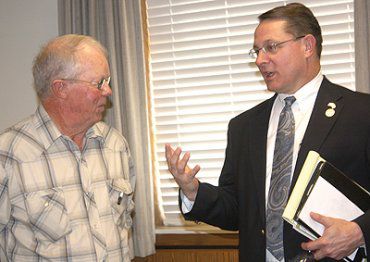Rep. Ken Ivory came to the Emery County Public Lands Council to share some of his insight into the question of whether federal lands should be returned to Utah for ownership. HB 148 recently passed by the Utah legislature and signed by Gov. Gary Herbert says just that, give Utah back lands which were promised when Utah became a state.
Rep. Ivory is the bill sponsor. Mike Swenson from USA-All introduced Rep. Ivory to the council. He said HB 148 could be useful to Emery County because 90 percent of Emery County is federal land.
Rep. Ivory said he was born across the hill in Sanpete County and it is his goal to return to an area like this some day. The issues facing Utah are huge he said, he explained that North Dakota and Utah became states about the same time. North Dakota has 3 percent federal lands and Utah has 65 percent. The enabling act said the people in Utah gave up their land until the time these lands should be disposed of by the federal government, which has never happened. Ivory said, “You’ve heard in the papers, that this will be thrown out of court, but the promises to the states should be the same.”
Ivory explained the history of the public lands trust and how land came to be sold to start new states and proceeds from these sales was to be used to pay down the national debt. By 1830, the national debt had been paid down. Any lands that couldn’t be sold were to be abandoned to the states. It was in the best interest of the United States to surrender the land to the states.
In North Dakota with 3 percent federal lands they have 20,000 jobs looking for people and are $3,700 above the national average in per pupil spending. Why is this? It’s because they have access to their lands and their resources. In Utah in per pupil spending the state is $3,700 below the national average. It would take an additional $2.2 billion per year to get to average. Ivory said some people say raise taxes or do away with the state exemption, but to raise taxes by $2 billion would kill the economy.
In Hawaii, they control their land. In the Utah budget there is $5.2 billion that Utah spends of federal funds annually, what happens when that money goes away with the financial crunch the United States is in at this time?
The super committee for finance reform recommended 9 percent across the board cuts for the federal government. They said reform entitlements and cut spending and increase revenue or the whole thing could collapse.
“In our state we have trillions of dollars worth of natural resources. Arguments are that you people in Utah would rape and pillage the land. The federal government is an absent landlord,” said Ivory.
Ivory said the bill takes Utah’s 33 wilderness areas off the table for possible Utah management as well as the National Parks and monuments within the state, but would recommend Utah take back the Grand Staircase Escalante National Monument. Ivory said he understands tourism and its importance in the Utah economy.
The bill uses the time frame of Dec. 31, 2014 for the return of the federal lands to Utah. The bill also creates a public land commission to protect the open space.
One concern public lands council members voiced was if the land is sold off and becomes private, then Utahns could lose their access. Ivory said that would not be the case and the open public lands would carry over the rights of access and the public lands commission would manage to those rights. He said when sale of lands is mentioned, it’s mainly for around towns where the individual town or city wants to grow and it is surrounded by public lands, then maybe some of these public lands can be sold so that town can expand.
Swenson said the whole process is exciting and scary at the same time. He believes Utah should take what belongs to it as the right of being a state. SITLA lands would remain the same, but work could take place to consolidate those lands for the good of the Utah school children. Leasing revenues for gas and oil production would 100 percent come into Utah instead of the federal government taking the royalties and paying a percentage back to the state where the mineral was extracted. “It’s not just about the revenues, we want to protect the health of the public lands,” said Swenson.
Public lands should Utah manage or the feds?

"Public Lands council member Sherrel Ward speaks with Rep. Ken Ivory about the federal government versus the state in the management of public lands in Utah."
